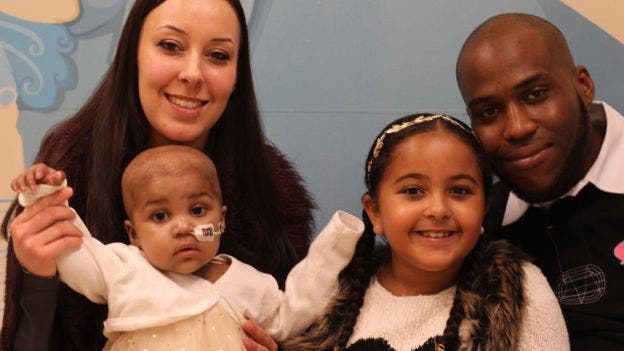When one-year-old Layla Richards, from London, was diagnosed with an aggressive strain of leukaemia, the word ‘incurable’ struck like a hammer. But thanks to an innovative approach that worked even better than expected, she now has all the chances to grow healthy.
As it usually happens to babies, chemo and bone marrow transplant didn’t work. Doctors had all but given up at that point, suggesting palliative treatment – focusing on reducing the symptoms, not treating the disease. But her dad wasn’t keen on this idea. He wanted a chance to save his daughter, no matter how risky this was. He told the BBC:
“I didn’t want to go down that road, I’d rather that she tried something new and I took the gamble. And this is her today standing laughing and giggling, she was so weak before this treatment, it was horrible and I’m just thankful for this opportunity.”
Medical staff, in conjunction with the biotech company Cellectis, had one last treatment in mind, and they acted on it fast. The treatment is called designer immune cells, and it uses micro-scissors to precisely engineer the DNA inside a donor’s immune cells. Basically, instead of adding the new genes to fix the problem, they try to edit the existing genes.
The treatment worked incredibly well. Just months after her parents learned that Layla has incurable cancer, not only is she alive and well – but there is no detectable trace of the disease in her body.
Dr Paul Veys, from Great Ormond Street, said the transformation was one of the most remarkable things he’d seen in 20 years:
“We’re in a wonderful place compared to where we were five months ago, but that doesn’t mean cure. “The only way we will find out if this is a cure is by waiting that one or two years, but even having got this far from where we were is a major, major step.”
He described this evolution as “almost a miracle”. In fact, it’s not even clear why this treatment worked out so good. Her story was shared at the American Society of Haematology, but this is only a single case – medics are now discussing the possibility of clinical trials, to better test and understand how this technique works. But the progress is phenomenal, and likely not a freak accident.
Prof Waseem Qasim, from Great Ormond Street, added:
“This is the first time human cells, engineered in this particular way, have been given back to a patient and that was a big step for us. The technology is moving very fast, the ability to target very specific regions of the genome have suddenly become much more efficient and we think that this technology will be the next phase of treatments. “The technology itself has got enormous potential to correct other conditions where cells are engineered and given back to patients or to provide new properties to cells that allow them to be used in a way we can only imagine at the moment.”










